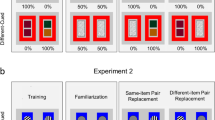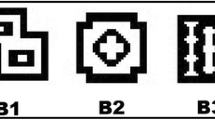Abstract
Authors including Lea (1984) have recently argued that true conceptual behavior is not based solely on perceptual similarity. We have developed a method for assessing nonsimilarity-based conceptualization in children that parallels an effective method for pigeons. This method has provided evidence that both species form classes of functionally equivalent, but perceptually different stimuli. Children and pigeons are thus capable of similarity-based and nonsimilarity-based conceptualization; in the former case differential reinforcement may be said to disclose preexisting concepts, whereas in the latter it may be said to produce new ones. The similarity of pigeons’ and children’s categorization behavior suggests that linguistic ability is not necessary for conceptualization.
Similar content being viewed by others
References
ASTLEY, S. L., & WASSERMAN, E. A. (1992). Categorical discrimination and generalization in pigeons: All negative stimuli are not created equal. Journal of Experimental Psychology: Animal Behavior Processes, 18, 193–207.
BHATT, R. S. (1988). Categorization in pigeons: Effects of category size, congruity with human categories, selective attention, and secondary generalization. Unpublished doctoral dissertation, University of Iowa, Iowa City.
BHATT, R. S., & WASSERMAN, E. A. (1989). Secondary generalization and categorization in pigeons. Journal of the Experimental Analysis of Behavior, 52, 213–224.
BHATT, R. S., WASSERMAN, E. A., REYNOLDS, W. F., Jr., & KNAUSS, K. S. (1988). Conceptual behavior in pigeons: Categorization of both familiar and novel examples from four classes of natural and artificial stimuli. Journal of Experimental Psychology. Animal Behavior Processes, 14, 219–234.
HERRNSTEIN, R. J. (1985). Riddles of natural categorization. Philosophical Transactions of the Royal Society B308, 129–144.
HERRNSTEIN, R. J., & DE VILLIERS, P. A. (1980). Fish as natural category for people and pigeons. In G. Bower (Ed.), The psychology of learning and motivation (pp. 59–95). San Diego, CA: Academic Press.
HERRNSTEIN, R. J., & LOVELAND, D. H. (1964). Complex visual concept in the pigeon. Science, 146, 549–551.
KELLER, F. S., & SCHOENFELD, W. N. (1950). Principles of psychology. New York: Appleton-Century-Crofts.
LEA, S. E. G. (1984). In what sense do pigeons learn concepts? In H. L. Roitblat, T. G. Bever, & H. S. Terrace (Eds.), Animal cognition (pp. 263–276). Hillsdale, NJ: Erlbaum.
OSGOOD, C. E. (1953). Method and theory in experimental psychology. New York: Oxford University Press.
ROSCH, E., & MERVIS, C. B. (1975). Family resemblances: Studies in the internal structure of categories. Cognitive Psychology. 7, 573–605.
SAUNDERS, R. P., & GREEN, G. (1992). The nonequivalence of behavioral and mathematical equivalence. Journal of the Experimental Analysis of Behavior, 57, 227–241.
SIDMAN, M., & TAILB, Y. W. (1982). Conditional discrimination vs. matching to sample: An expansion of the testing paradigm. Journal of the Experimental Analysis of Behavior, 37, 5–22.
SMITH, E. E., & MEDIN, D. L. (1981). Categories and concepts. Cambridge, MA: Harvard University Press.
URCUIOLI, P. J., ZENTALL, T. R., JACKSON-SMITH, P., & STEIRN, J. N. (1989). Evidence for common coding in many-to-one matching: Retention, intertrial interference, and transfer. Journal of Experimental Psychology: Animal Behavior Processes, 15, 264–273.
VAUGHAN, W., Jr.. (1988). Formation of equivalence sets in pigeons. Journal of Experimental Psychology: Animal Behavior Processes, 14, 36–42.
WASSERMAN, E. A., DEVOLDER, C. L., & COPPAGE, D. J. (1992). Nonsimilarity-based conceptualization in pigeons. Psychological Science, 3, 374–379.
WASSERMAN, E. A., KIEDINGER, R. E., & BHATT, R. S. (1988). Conceptual behavior in pigeons: Categories, subcategories, and pseudocategories. Journal of Experimental Psychology: Animal Behavior Processes, 14, 235–246.
ZENTALL, T. R., STEIRN, J. N., SHERBURNE, L. M., & URCUIOLI, P. J. (1991). Common coding in pigeons assessed through partial versus total reversals of many-to-one conditional and simple discriminations. Journal of Experimental Psychology: Animal Behavior Processes, 17, 194–201.
Author information
Authors and Affiliations
Additional information
This research was supported by NIMH Grant MH 47313.
Rights and permissions
About this article
Cite this article
Wasserman, E.A., Devolder, C.L. Similarity- and Nonsimilarity-Based Conceptualization in Children and Pigeons. Psychol Rec 43, 779–793 (1993). https://doi.org/10.1007/BF03395912
Published:
Issue Date:
DOI: https://doi.org/10.1007/BF03395912




